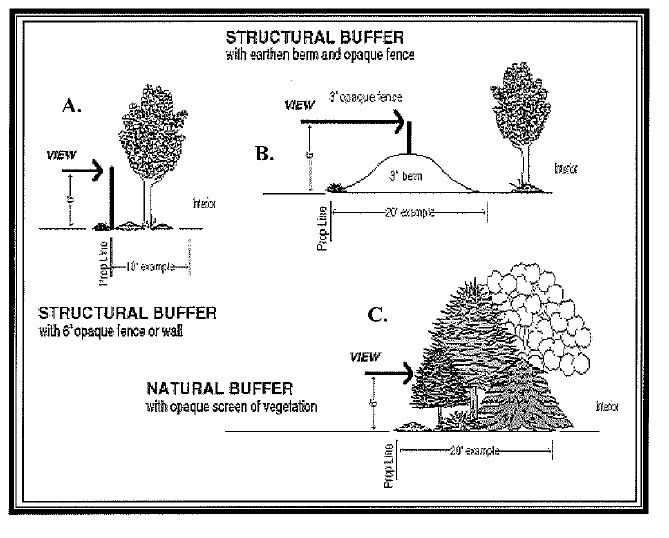Required buffer yards shall comply with the minimum standards in this section. The image at the end of this section provides illustrations of acceptable buffering techniques.
(A) Natural buffers.
(1) At a minimum, natural buffers shall consist of existing vegetation that provides an opaque natural visual screen to a height of at least six feet, or any combination of existing and replanted vegetation that can reasonably be expected to create an opaque visual screen at least six feet high within five growing seasons.
(2) Natural buffers may contain deciduous or perennial vegetation, but shall contain evergreen shrubs, bushes and trees suitable to local growing conditions that will provide an opaque visual screen during all seasons of the year, in accordance with the following.
(1) (a) Natural buffers shall include at least one evergreen shrub planted every four feet, at least one evergreen tree planted every 25 feet, and at least one deciduous tree planted every 50 feet.
(b) The minimum width of all natural buffers shall be 20 feet.
(2) (a) The retention of existing vegetation should be preserved to the maximum extent practical.
(b) The addition of new vegetation may be required if vegetation retained is not sufficient.
(3) (a) Natural buffers shall be sufficient in opacity to screen automobile headlights from areas zoned residential or agriculture.
(b) The city may require a landscaped berm or a structure buffer, such as walls or fences, to achieve the desired level of screening needed.
(4) (a) Generally, all trees and bushes used within a required buffer area shall be adequate in quantity and type to provide the necessary screening or buffering as determined by the city.
(b) Buffer areas shall comply with the standards herein.
(B) Structural buffers. Structural buffers shall meet the following criteria.
(1) Structural buffers shall be vegetated throughout the minimum area required for the buffer around any fences or walls and upon any earthen berms, which may include grass, ground covers, shrubs and trees.
(2) (a) Structural buffers shall include at least one evergreen shrub planted every ten feet, at least one evergreen tree planted every 25 feet, and at least one deciduous tree planted every 50 feet.
(b) The minimum width of all structural buffers shall be ten feet.
(3) (a) All earthen berms shall have a maximum side slope of three horizontal to one vertical.
(b) Earthen berms shall not be constructed within the drip line of any existing trees that will remain on the property.
(4) (a) Fences and freestanding walls of brick, stone or ornamental concrete shall meet the standards of § 158.056 of this chapter, and shall be designed to present a finished and decorative appearance on both sides.
(b) Unless otherwise waived by the Director, fences and walls shall be placed on the property line, and the shrubs, ground covers or other vegetation shall be provided on the interior side of the fence or wall.

(Ord. 3474, passed 9-5-2006)